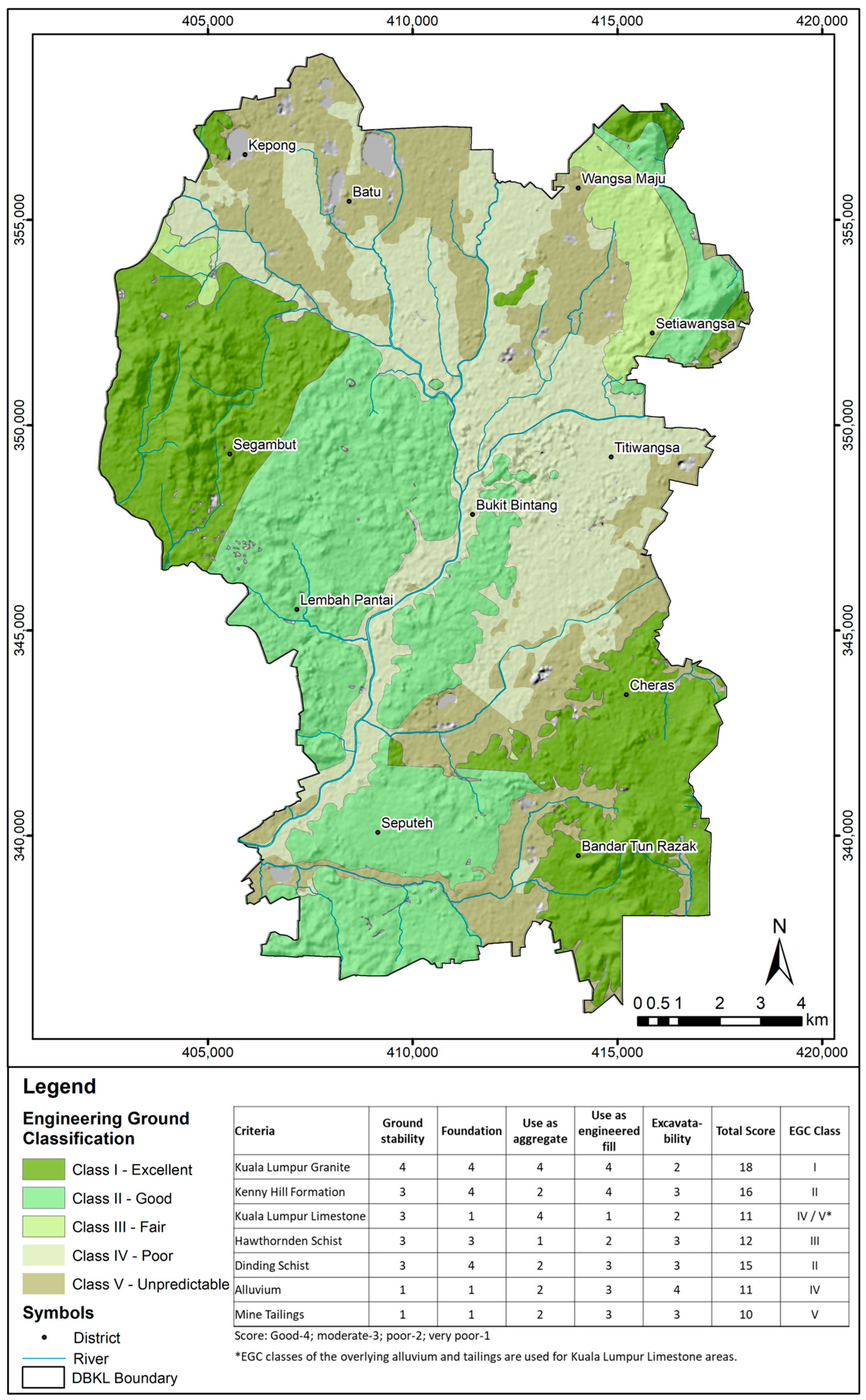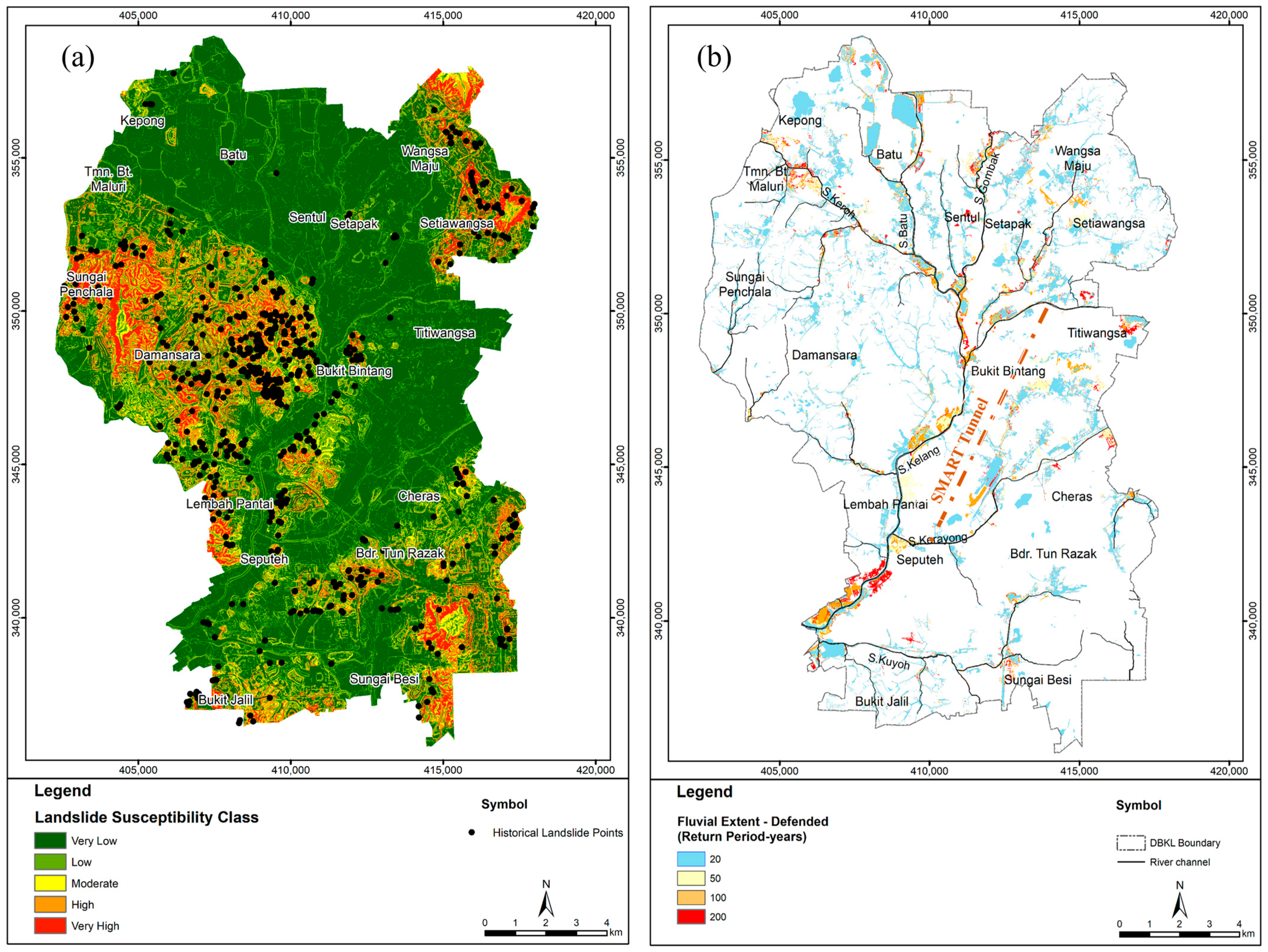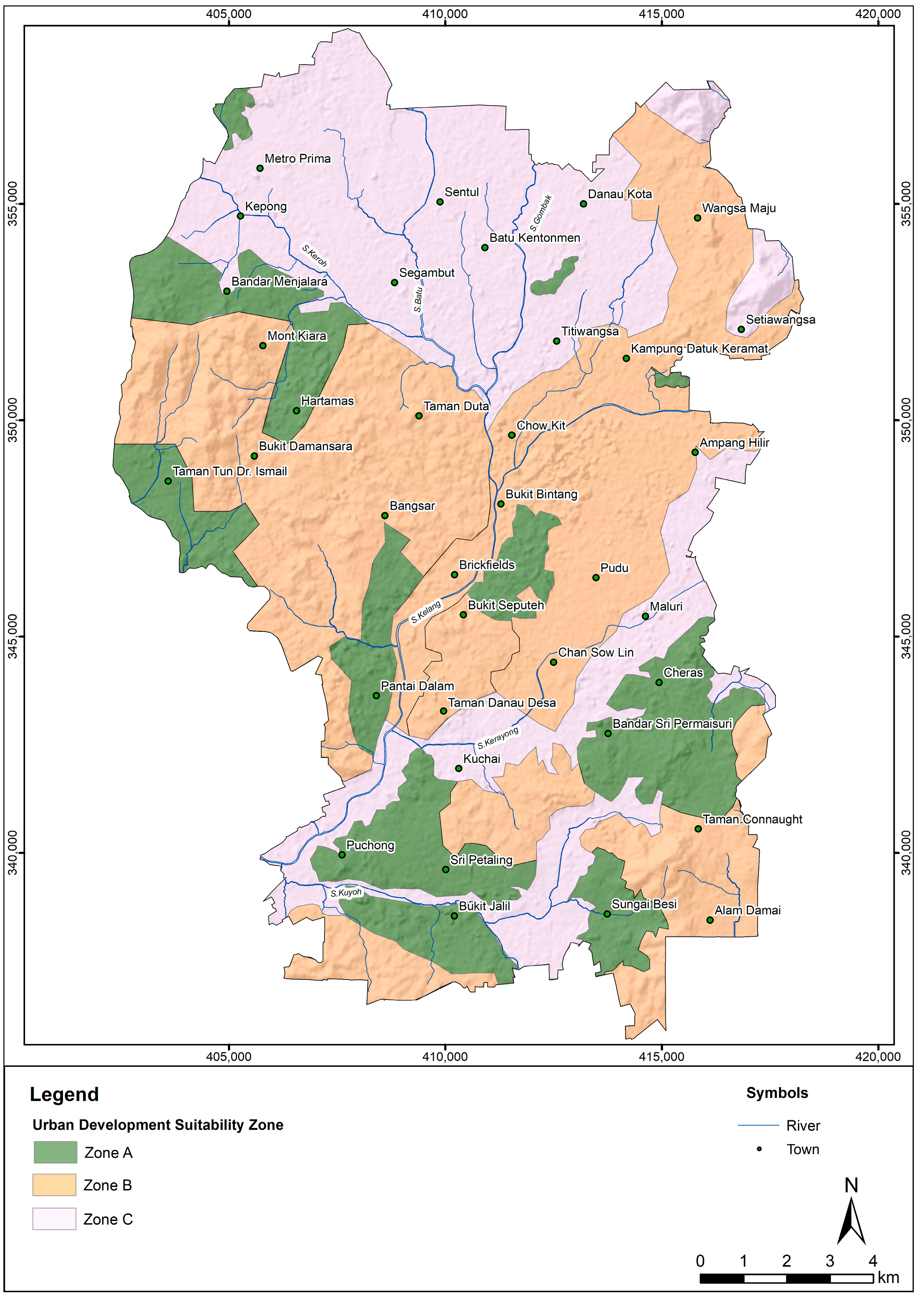Integration of Geoscience Information for Disaster Resilience in Kuala Lumpur, Malaysia
Abstract
:1. Introduction
2. Materials and Methods
2.1. Study Area
2.2. Acquisition of Geoscience Information
2.3. Assessment of Geoscience Information
- Assessment of engineering geology condition
- Assessment of geohazard susceptibility
2.4. Integration of Geoscience Models and Zonation
3. Results
3.1. Engineering Ground Classification
3.2. Geohazard Susceptibility
3.3. Urban Development Suitability and Development Planning Zones
4. Discussion
5. Conclusions
Author Contributions
Funding
Institutional Review Board Statement
Informed Consent Statement
Data Availability Statement
Acknowledgments
Conflicts of Interest
References
- Hosseini, S.; Barker, K.; Ramirez-Marquez, J.E. A review of definitions and measures of system resilience. Reliab. Eng. Syst. Saf. 2016, 145, 47–61. [Google Scholar] [CrossRef]
- Meerow, S.; Newell, J.; Stults, M. Defining urban resilience: A review. Landsc. Urban Plan. 2016, 147, 38–49. [Google Scholar] [CrossRef]
- Ahern, J. From fail-safe to safe-to-fail: Sustainability and resilience in the new urban world. Landsc. Urban Plan. 2011, 100, 341–343. [Google Scholar] [CrossRef] [Green Version]
- UNISDR. UNISDR Terminology on Disaster Risk Reduction. Available online: https://www.preventionweb.net/publication/2009-unisdr-terminology-disaster-risk-reduction (accessed on 28 December 2022).
- Xu, H.; Li, Y.; Tan, Y.; Deng, N. A Scientometric Review of Urban Disaster Resilience Research. Int. J. Environ. Res. Public Health 2021, 18, 3677. [Google Scholar] [CrossRef]
- Bozza, A.; Asprone, D.; Manfredi, G. Developing an integrated framework to quantify resilience of urban systems against disasters. Nat Hazards 2015, 78, 1729–1748. [Google Scholar] [CrossRef]
- IPCC. Summary for Policymakers. In Climate Change 2022: Impacts, Adaptation, and Vulnerability. Contribution of Working Group II to the Sixth Assessment Report of the Intergovernmental Panel on Climate Change; Pörtner, H.-O., Roberts, D.C., Poloczanska, E.S., Mintenbeck, K., Tignor, M., Alegría, A., Craig, M., Langsdorf, S., Löschke, S., Möller, V., et al., Eds.; Cambridge University Press: Cambridge, UK, 2022. [Google Scholar]
- Gavari-Starkie, E.; Casado-Claro, M.-F.; Navarro-González, I. The Japanese Educational System as an International Model for Urban Resilience. Int. J. Environ. Res. Public Health 2021, 18, 5794. [Google Scholar] [CrossRef] [PubMed]
- Sanchez, A.X.; Van der Heijden, J.; Osmond, P. The city politics of an urban age: Urban resilience conceptualisations and policies. Palgrave Commun. 2018, 4, 25. [Google Scholar] [CrossRef] [Green Version]
- United Nations, U. Goal 11: Make Cities Inclusive, Safe, Resilient and Sustainable. Available online: https://www.un.org/sustainabledevelopmhttps://sdgs.un.org/goals/goal11 (accessed on 18 August 2021).
- Yang, Y.; Ng, S.T.; Xu, F.J.; Skitmore, M. Towards sustainable and resilient high density cities through better integration of infrastructure networks. Sustain. Cities Soc. 2018, 42, 407–422. [Google Scholar] [CrossRef]
- IPCC. An IPCC Special Report on the impacts of global warming of 1.5 °C above pre-industrial levels andrelated global greenhouse gas emission pathways, in the context of strengthening the global response to the threat of climate change, sustainable development, and efforts to eradicate poverty. In Global Warming of 1.5 °C; Masson-Delmotte, V., Zhai, P., Pörtner, H.-O., Roberts, D., Skea, J., Shukla, P.R., Pirani, A., Moufouma-Okia, W., Péan, C., Pidcock, R., et al., Eds.; IPCC: Geneva, Switzerland, 2018. [Google Scholar]
- Yamori, K.; Goltz, J.D. Disasters without Borders: The Coronavirus Pandemic, Global Climate Change and the Ascendancy of Gradual Onset Disasters. Int. J. Environ. Res. Public Health 2021, 18, 3299. [Google Scholar] [CrossRef] [PubMed]
- Kong, L.M.Z.; Hu, G.; Zhang, Z. The application of resilience theory in urban development: A literature review. Environ. Sci. Pollut. Res. 2022, 29, 49651–49671. [Google Scholar] [CrossRef]
- Liu, L.L.Y.; Zhuang, M.; Ding, S. The impact of climate change on urban resilience in the Beijing-Tianjin-Hebei region. Sci. Total Environ. 2022, 827, 154157. [Google Scholar] [CrossRef] [PubMed]
- Rau, J. The State of Geosecurity in Asian Cities. In Ground Beneath Our Feet: A Factor in Urban Planning. Atlas of Urban Geology; United Nations Publications: New York, NY, USA, 2003; Volume 14, p. 488. [Google Scholar]
- Pereira, J.J.; Ng, T.; Hunt, J. Climate Action. In Geosciences and the Sustainable Development Goals, Sustainable Development Goals Series; Gill, J.C., Smith, M., Eds.; Springer Nature: Cham, Switzerland, 2021; pp. 313–337. [Google Scholar]
- Affandi, E.; Ng, T.F.; Pereira, J.J.; Ahmad, F.; Banks, V.J. Revalidation Technique on Landslide Susceptibility Modelling: An Approach to Local Level Disaster Risk Management in Kuala Lumpur, Malaysia. Appl. Sci. 2023, 13, 768. [Google Scholar] [CrossRef]
- U.S. Geological Survey. Geoscience for a Changing World; U.S. Geological Survey: Reston, VA, USA, 2018.
- National Research Council. Geoscience Data and Information for Decision Making; National Academies Press: Washington, DC, USA, 2007.
- Omar, R.C.; Komoo, I.; Hashim, H.S.; Aziz, S.; Yaakub, J. Incorporating of geosciences framework for sustainable development at MSC. Bull. Geol. Soc. Malays. 2002, 45, 93–96. [Google Scholar] [CrossRef]
- Malczewski, J. GIS-based land-use suitability analysis: A critical overview. Prog. Plan. 2004, 62, 3–65. [Google Scholar] [CrossRef]
- Bagheri, M.; Zaiton Ibrahim, Z.; Mansor, S.; Manaf, L.A.; Akhir, M.F.; Talaat, W.I.A.W.; Beiranvand Pour, A. Land-Use Suitability Assessment Using Delphi and Analytical Hierarchy Process (D-AHP) Hybrid Model for Coastal City Management: Kuala Terengganu, Peninsular Malaysia. ISPRS Int. J. Geo-Inf. 2021, 10, 621. [Google Scholar] [CrossRef]
- Liu, R.; Zhang, K.; Zhang, Z.; Borthwick, A. Land-use suitability analysis for urban development in Beijing. J. Environ. Manag. 2014, 145, 170–179. [Google Scholar] [CrossRef] [Green Version]
- Yang, Y.; Tang, X.-L.; Li, Z.-H. Land use suitability analysis for town development planning in Nanjing hilly areas: A case study of Tangshan new town, China. J. Mt. Sci. 2021, 18, 528–540. [Google Scholar] [CrossRef]
- Labiso, T.T.; Yagaso, Z.S. Land suitability analysis for surface irrigation in Humbo woreda, wolaita zone, Southern Ethiopia. EQA 2021, 44, 32–43. [Google Scholar] [CrossRef]
- Dai, F.; Lee, C.; Zhang, X. GIS-based geo-environmental evaluation for urban land-use planning: A case study. Eng. Geol. 2001, 61, 257–271. [Google Scholar] [CrossRef]
- El May, M.; Dlala, M.; Chenini, I. Urban geological mapping: Geotechnical data analysis for rational development planning. Eng. Geol. 2010, 116, 129–138. [Google Scholar] [CrossRef]
- Reichenbach, P.; Rossi, M.; Malamud, B.D.; Mihir, M.; Guzzetti, F. A review of statistically-based landslide susceptibility models. Earth Sci. Rev. 2018, 180, 60–91. [Google Scholar] [CrossRef]
- Mudashiru, R.B.; Sabtu, N.; Abustan, I. Quantitative and semi-quantitative methods in flood hazard/susceptibility mapping: A review. Arab. J. Geosci. 2021, 14, 941. [Google Scholar] [CrossRef]
- Daniel, M.T.; Ng, T.F.; Kadir, A.; Farid, M.; Pereira, J.J. Landslide Susceptibility Modeling Using a Hybrid Bivariate Statistical and Expert Consultation Approach in Canada Hill, Sarawak, Malaysia. Front. Earth Sci. 2021, 9, 616225. [Google Scholar] [CrossRef]
- Muhamad, N.; Arshad, S.H.M.; Pereira, J.J. Exposure Elements in Disaster Databases and Availability for Local Scale Application: Case Study of Kuala Lumpur, Malaysia. Front. Earth Sci. 2021, 9, 616246. [Google Scholar] [CrossRef]
- Luan, C.; Liu, R.; Peng, S. Land-use suitability assessment for urban development using a GIS-based soft computing approach: A case study of Ili Valley, China. Ecol. Indic. 2021, 123, 107333. [Google Scholar] [CrossRef]
- Artikov, T.U.; Ibragimov, R.S.; Ibragimova, T.L.; Mirzaev, M.A. Complex of general seismic zoning maps OSR-2017 of Uzbekistan. Geod. Geodyn. 2020, 11, 273–292. [Google Scholar] [CrossRef]
- Fan, Y.; Suwen, X.; Jiangang, O.; Ziyu, Z.; Ting, L. Human Settlement Resilience Zoning and Optimizing Strategies for River-Network Cities under Flood Risk Management Objectives: Taking Yueyang City as an Example. Sustainability 2022, 14, 9595. [Google Scholar] [CrossRef]
- Batarseh, M.; Imreizeeq, E.; Tilev, S.; Al Alaween, M.; Suleiman, W.; Al Remeithi, A.M.; Al Tamimi, M.K.; Al Alawneh, M. Assessment of groundwater quality for irrigation in the arid regions using irrigation water quality index (IWQI) and GIS-Zoning maps: Case study from Abu Dhabi Emirate, UAE. Groundw. Sustain. Dev. 2021, 14, 100611. [Google Scholar] [CrossRef]
- Doorga, J.R.S.; Magerl, L.; Bunwaree, P.; Zhao, J.; Watkins, S.; Staub, C.G.; Rughooputh, S.D.D.V.; Cunden, T.S.M.; Lollchund, R.; Boojhawon, R. GIS-based multi-criteria modelling of flood risk susceptibility in Port Louis, Mauritius: Towards resilient flood management. Int. J. Disaster Risk Reduct. 2022, 67, 102683. [Google Scholar] [CrossRef]
- Fischer, K.; Häring, I.; Riedel, W.; Vogelbacher, G.; Hiermaier, S. Susceptibility, vulnerability, and averaged risk analysis for resilience enhancement of urban areas. Int. J. Prot. Struct. 2016, 7, 45–76. [Google Scholar] [CrossRef]
- Mabrouk, M.; Haoying, H. Urban resilience assessment: A multicriteria approach for identifying urban flood-exposed risky districts using multiple-criteria decision-making tools (MCDM). Int. J. Disaster Risk Reduct. 2023, 91, 103684. [Google Scholar] [CrossRef]
- DBKL. Draft of Kuala Lumpur Structure Plan 2040: A City for All; Dewan Bandaraya Kuala Lumpur: Kuala Lumpur, Malaysia, 2021. [Google Scholar]
- Petley, D. On the impact of urban landslides. Geol. Soc. Lond. Eng. Geol. Spec. Publ. 2009, 22, 83–99. [Google Scholar] [CrossRef]
- Chand, F. Environmental geology in urban development. In Proceedings of the Ninth Regional Congress on Geology, Mineral and Energy Resources of Southeast Asia—GEOSEA’98, Kuala Lumpur, Malaysia, 17–19 August 1999; pp. 329–333. [Google Scholar]
- Pereira, J.J.; Komoo, I. Geoscience in landuse planning for environmental sustainability. Bull. Geol. Soc. Malays. 2006, 52, 7–15. [Google Scholar] [CrossRef]
- Elmahdy, S.I.; Mostafa, M.M. Natural hazards susceptibility mapping in Kuala Lumpur, Malaysia: An assessment using remote sensing and geographic information system (GIS). Geomat. Nat. Haz. Risk. 2013, 4, 71–91. [Google Scholar] [CrossRef]
- Suratman, S. Engineering Geological Mapping of Wilayah Persekutuan and Surrounding Areas; UG/1/1993; Geological Survey of Malaysia: Kuala Lumpur, Malaysia, 1993. [Google Scholar]
- Althuwaynee, O.F.; Pradhan, B. Semi-quantitative landslide risk assessment using GIS-based exposure analysis in Kuala Lumpur City. Geomat. Nat. Haz. Risk. 2017, 8, 706–732. [Google Scholar] [CrossRef] [Green Version]
- Tan, B.K. Urban Geology: Case Studies in Malaysia. In Proceedings of the ISRM International Symposium, Melbourne, Australia, 19–24 November 2000. [Google Scholar]
- Ng, T.F. Joint characteristics in granitic rocks of eastern Kuala Lumpur, Peninsular Malaysia. War. Geol. 1994, 20, 5–18. [Google Scholar]
- Tan, B.K. Urban Geology of Kuala Lumpur and Ipoh, Malaysia. In Engineering Geology Special Publication: Engineering Geology of Tomorrow’s Cities; Geological Society London: London, UK, 2006; Volume 22. [Google Scholar]
- Massam, A.; Smith, H.; Filipova, V.; Waller, S.; Muhamad, N.; Pereira, J.J. Flood risk in Kuala Lumpur, Malaysia: A consideration of flood defences in a broadscale hydraulic model. J. Flood Risk Manag. 2023, e12907. [Google Scholar] [CrossRef]
- Gobbett, D. The lower palaeozoic rocks of Kuala Lumpur, Malaysia. Fed. Mus. J. 1964, 9, 67–79. [Google Scholar]
- Yin, E.H. The Geology and Mineral Resources of the Kuala Lumpur-Klang Area; Unpublished Report; Geological Survey Department of Malaysia: Kuala Lumpur, Malaysia, 1986.
- Tálita de Sena Nola, I.; Zuquette, L.V. Procedures of engineering geological mapping applied to urban planning in a data-scarce area: Application in southern Brazil. J. South Am. Earth Sci. 2021, 107, 103141. [Google Scholar] [CrossRef]
- Van Westen, C.J.; Castellanos, E.; Kuriakose, S.L. Spatial data for landslide susceptibility, hazard, and vulnerability assessment: An overview. Eng. Geol. 2008, 102, 112–131. [Google Scholar] [CrossRef]
- Süzen, M.L.; Doyuran, V. A comparison of the GIS based landslide susceptibility assessment methods: Multivariate versus bivariate. Env. Geol. 2004, 45, 665–679. [Google Scholar] [CrossRef]
- Van Westen, C. Statistical landslide hazard analysis. In ILWIS 2.1 For Windows Application Guide; ITC Publication: Enschede, The Netherlands, 1997; pp. 73–84. [Google Scholar]
- Flentje, P.N.; Miner, A.; Whitt, G.; Fell, R. Guidelines for Landslide Susceptibility, Hazard and Risk Zoning for Land Use Planning. Available online: https://ro.uow.edu.au/engpapers/2823 (accessed on 25 January 2021).
- Massam, A.; Smith, H. Urban Flood Modelling in Kuala Lumpur. In Proceedings of the Technical Presentation on Urban Flood Modelling in Kuala Lumpur, Kuala Lumpur, Malaysia, 18 December 2020. [Google Scholar]
- Webb, D. Kuala Lumpur: A Model of Resilience. Available online: https://www.jbarisk.com/news-blogs/kuala-lumpur-a-model-of-resilience/ (accessed on 12 December 2021).
- Mulder, E.; Pereira, J. Earth Science for the city. Geol. Soc. Lond. Eng. Geol. Spec. Publ. 2009, 22, 25–31. [Google Scholar] [CrossRef]
- Bathrellos, G.D.; Skilodimou, H.D.; Chousianitis, K.; Youssef, A.M.; Pradhan, B. Suitability estimation for urban development using multi-hazard assessment map. Sci. Total Environ. 2017, 575, 119–134. [Google Scholar] [CrossRef] [PubMed]
- IPCC. Summary for Policymakers. In Climate Change 2021: The Physical Science Basis. Contribution of Working Group I to the Sixth Assessment Report of the Intergovernmental Panel on Climate Change; Masson-Delmotte, V., Zhai, P., Pirani, A., Connors, S.L., Péan, C., Berger, S., Caud, N., Chen, Y., Goldfarb, L., Gomis, M.I., et al., Eds.; Cambridge University Press: Cambridge, UK, 2021. [Google Scholar]
- Zervakou, A.; Tsombos, P. GIS in urban geology: The case study of Nafplio, Argolis Prefecture, Greece. Bull. Geol. Soc. Greece 2017, 43, 1559–1571. [Google Scholar] [CrossRef] [Green Version]
- Xie, D.; Gao, S.; Wang, Z.B.; Pan, C.; Wu, X.; Wang, Q. Morphodynamic modeling of a large inside sandbar and its dextral morphology in a convergent estuary: Qiantang Estuary, China. J. Geophys. Res. Earth Surf. 2017, 122, 1553–1572. [Google Scholar] [CrossRef] [Green Version]
- Xie, D.; Bing Wang, Z.; Huang, J.; Zeng, J. River, tide and morphology interaction in a macro-tidal estuary with active morphological evolutions. CATENA 2022, 212, 106131. [Google Scholar] [CrossRef]
- Banks, V.J.; Bricker, S.H.; Affandi, E.; Ng, T.F. The Role of Urban Geoscience in Building a More Resilient Kuala Lumpur. In Proceedings of the Workshop on Disaster and Climate Resilience in Cities, Kuala Lumpur, Malaysia, 15–16 October 2019. [Google Scholar]






| Suitability | Description |
|---|---|
| I—High (UDS Class I) | Areas with negligible flood or landslides occurrence and where the ground is classified as having EGC Class I or Class II. |
| II—Moderate (UDS Class II) | Areas where geohazards are negligible; the ground is identified as having EGC Class III or Class IV. Flood hazard may be present in areas where the ground is classified as having EGC Class I. |
| III—Low (UDS Class III) | Flood hazard may be present in areas where the ground is classified as having EGC Class II to Class V. Landslide hazard or both geohazards may be present in areas underlain by ground classified as having EGC Class I to Class V. |
Disclaimer/Publisher’s Note: The statements, opinions and data contained in all publications are solely those of the individual author(s) and contributor(s) and not of MDPI and/or the editor(s). MDPI and/or the editor(s) disclaim responsibility for any injury to people or property resulting from any ideas, methods, instructions or products referred to in the content. |
© 2023 by the authors. Licensee MDPI, Basel, Switzerland. This article is an open access article distributed under the terms and conditions of the Creative Commons Attribution (CC BY) license (https://creativecommons.org/licenses/by/4.0/).
Share and Cite
Affandi, E.; Ng, T.F.; Pereira, J.J. Integration of Geoscience Information for Disaster Resilience in Kuala Lumpur, Malaysia. Appl. Sci. 2023, 13, 7004. https://doi.org/10.3390/app13127004
Affandi E, Ng TF, Pereira JJ. Integration of Geoscience Information for Disaster Resilience in Kuala Lumpur, Malaysia. Applied Sciences. 2023; 13(12):7004. https://doi.org/10.3390/app13127004
Chicago/Turabian StyleAffandi, Elanni, Tham Fatt Ng, and Joy Jacqueline Pereira. 2023. "Integration of Geoscience Information for Disaster Resilience in Kuala Lumpur, Malaysia" Applied Sciences 13, no. 12: 7004. https://doi.org/10.3390/app13127004







